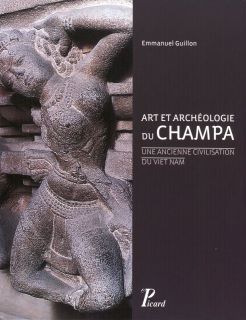| |
|
|
News
Review of “Art et Archéologie du Champa”, Emmanuel Guillon, on Union de la Presse Francophone website.
20 July 2012 
There was once a forgotten empire, named Champa… From a long reign, between the fourth to the seventeenth century, remains today a string of ruins hidden in the jungle that decorates the Vietnam central coast with the vestiges of kalans, those mysterious sanctuaries reduced to a few time-worn red bricks towers.
The Cham also left highly regarded works of art. now widely dispersed in museums or in the showcases of few eminent private collectors. However, the great Cham people, were pressed by the Khmer on the west and then pushed back and crushed by the Viêt in their march toward the South; exhausted, they finally vanished from memory.
Nowadays, a population of approximately one hundred thousand people live in communities scattered between Thailand, Cambodia and in particular Vietnam where they are noted for their traditions, costumes and especially religion (Hinduism or Islam).
In Art et archéologie du Champa, Emmanuel Guillon, thanks to his comprehensive catalogue and meticulous attention, takes us exploring the trail of this lost world, whose history is virtually unknown, enlightening us about a still mythical, crucial and unexplored past of the Indochinese peninsula.
Discovered at the very end of the nineteenth century, the Kingdom of Champa raised curiosity among scholars of the nascent École française d’Extrême-Orient, who began to collect objects and list archeological sites. But, following the succession of being the victim of the tremendous fascination generated by the discovery of Angkor, then of the long period of Vietnam wars (1940 -1975) and the
complex issue of the role of minorities in the struggle for independence and national reconstruction, the Cham past faded quickly into oblivion.
When finally peace was restored, research and excavations of the ancient archeological sites could resume in the nineties, bringing a new look to this important part of the Vietnam history, which now presents an excellent opportunity to the growing tourism industry. In the south-central region of the country, from Phan Thiet to Da Nang, in areas mostly devastated by the wars, many monuments,
such as My Son or Po Nagar, are still standing. And new museums opened on these sites, then completed the very important collections inherited from French administration in Hanoi, Danang (ex-Tourane) and Ho Chi Minh-Ville (ex-Saigon).
At the request of Jean Boisselier (1912-1996), Emmanuel Guillon, an orientalist scholar and a passionate researcher of Cham civilization, philosopher and ethnologist by training, continued research studies. He has revived the adventure, posing in his book the questions of today on the Cham world barely known yesterday. He calls for new archeological excavations and proposes to expand the research to Indonesian and Burmese territories.
Thanks to the knowledge, which greatly improved over the past twenty years, Art et archéologie du Champa is the first complete work on the forgotten Champa culture, thus making it a new basis for historical research.
With the cross-disciplinary use of archeology, epigraphy and geography, finally emerge from the old stones an abunding life, an original people and a real culture, a civilization in itself that gives to the Cham world its place and its historical significance without reducing it to an only aesthetic and legendary era of the South-East Asia history.
Formerly seen as an avatar of Hinduism, the aesthetic qualities of Cham works of art, when identified, were used more for commercial value than for recognition of an authentic people and their historical role. Well-founded works establishing Champa "scientific" existence and "conscience" were lacking. In his book, by restoring the existence of this fundamental element of memory, Emmanuel Guillon opens up new ways for approaching a non-Vietnamese side of the Vietnam’s history, which is totally part of its culture. A considerable and fruitful improvement.
All this is recorded in this wonderful book - abounding with photos and maps, with a comprehensive inventory of known sites and a complete bibliography - which should not only being looked at, but should also encourage curiosity and reflection on Vietnam’s great and diverse past
Emmanuel GUILLON, Art et archéologie du Champa. Une ancienne civilisation du Viet Nam,
éditions Picard, Paris, 246 p., 54 euros.
|
|


 James H.W. Thompson Foundation, Bangkok, Thailand.
James H.W. Thompson Foundation, Bangkok, Thailand.